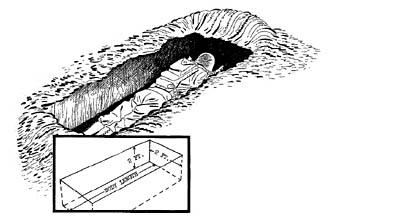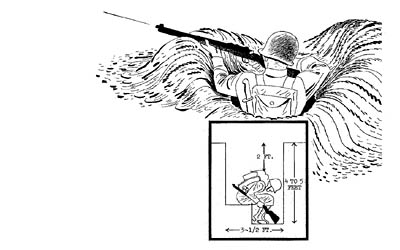From The Ordnance Soldier’s Guide, 3rd Edition, Ordnance Replacement Training Center, Aberdeen Proving Ground:
Hasty Field Fortifications
INDIVIDUAL PRONE SHELTER OR SLIT TRENCH: Whenever our troops halt anywhere near the Jap or Nazi troops, they begin at once to give themselves and their weapons individual protection. If it’s a short halt, they use the natural protection of the ground — bumps, ditches, shell holes, depressions of any kind. But if it’s a longer halt (but less than six hours, in an assembly area before an attack), then each man digs himself an individual prone shelter. This takes only a few minutes. Such a shelter gives a soldier two advantages — a chance to rest and reasonable protection from bomb, mortar, and shell fragments and small-arms fire. But this kind of a foxhole won’t protect you against a tank attack
STANDING TYPE FOXHOLE: If an outfit is to halt for more than five or six hours, it goes to work at once on standing-type one-man foxholes. These will protect you against all bombs and shells (except direct hits), bomb and shell fragments, and small-arm fire. And if you dig your foxhole deep enough to leave a clearance of two feet or more between you and the ground surface, when you’re crouched down in the bottom, you’ll have protection against the average Nazi or Jap tank. When you start to dig this foxhole, you put the sod to one side. The rest of the dirt you pile irregularly around the edges of the hole. And then, when you’re through digging, you use the sod to cover the rest of the dirt.












Good summary. If you aren’t walking, dig.
Superior post! Thanks.
Same instructions in the military today — dig, dig, dig, and dig more.
The first drawing looks too much like a grave.